Coastal Bridge Hits the Right Blend with Stansteel’s Accu-Shear Blending System
BY AsphaltPro Staff
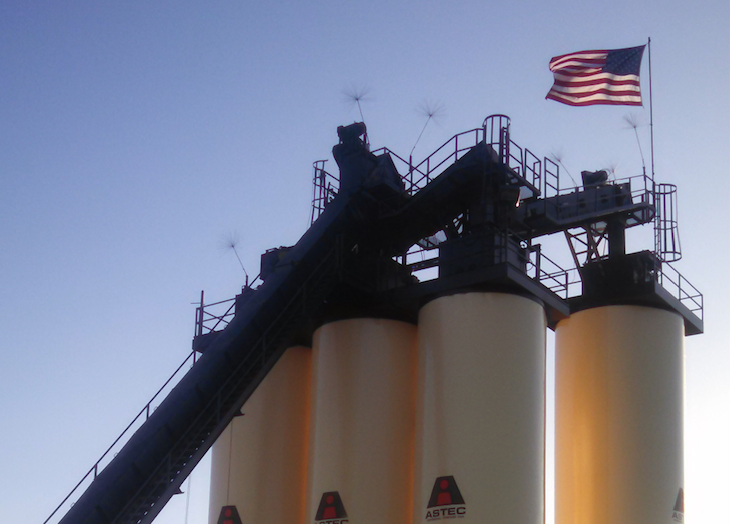
Ever since its formation in the 1950s, Coastal Bridge has focused on expansion and improvement.
As the name would imply, Coastal Bridge got its start building bridges in the 1950s before expanding to soil work in the ’70s and asphalt in the late ’80s.
Today, Coastal Bridge employs between 350 and 400 people in the asphalt division of the company, which also has bridge, industrial and commercial divisions.
Its four asphalt plants—all Astec double drums running 350 tons per hour—are located in Baton Rouge, Convent and Lafayette, Louisiana, and in Tampa, Florida. Roughly 70 percent of the 400,000 tons of mix it makes annually gets laid by its four laydown crews on projects ranging from parking lots to interstate highways.
In the spirit of expansion, Coastal Bridge bought the Tampa plant just two and a half years ago, hoping to add another 150,000 to its annual tonnage. And, in the near future, Coastal Bridge also expects to add a fifth crew, based in Tampa.
And, in 2012, Coastal Bridge purchased its first Stansteel Accu-Shear Blending System to continue its history of continuous growth and improvement. After experiencing a slew of unexpected benefits, in addition to the ability to foam its mixes, Coastal Bridge purchased a second Accu-Shear for one of its other plants.
But, the road to this point was paved with plenty of issues—no pun intended.
Coastal Bridge Blends for Better Mix
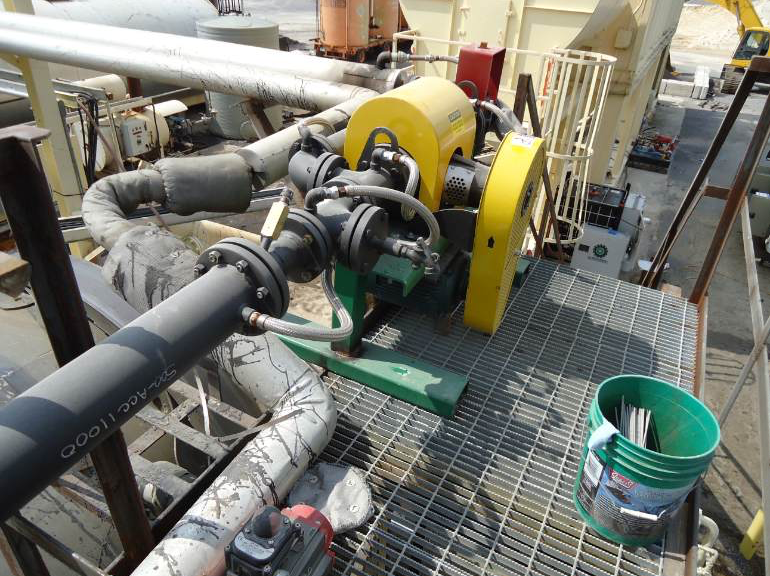
Coastal Bridge purchased its first Stansteel Accu-Shear Blending System in 2012. After noticing its many benefits, the company purchased a second Accu-Shear for another of its plants.
When Coastal Bridge first began foaming its material eight or nine years ago, their foaming gun was a pain. The AC going through would often clog the water ports.
That’s when Coastal Bridge Manager Kent Langley first started conversing with Rick Rees from Stansteel about the Accu-Shear.
“We could see the benefits of the Accu-Shear would outweigh what we had at the plant already,” Langley said. These conversations just so happened to occur around the time Louisiana agreed to allow latex-modified asphalt cement (AC) to replace PG70-22 polymer modified AC.
But, it would still be a while before Langley would get the equipment he now knew he wanted. Instead, Coastal Bridge purchased an inline blender.
“Some samples would pass and some would fail, because the latex was floating on top of the tube system, so it wasn’t totally blended in,” Langley said. So, the company tried a different, fluted blender and placed it on its Lafayette plant. Although it worked much better, it would use more latex to obtain the same values—1.7 percent through the Accu-Shear versus 1.8 to 1.9 percent through the fluted blender.
So, finally, the company purchased the Accu-Shear. “We put it on the Baton Rouge plant and ran another job, and it was a piece of cake. The tests were consistent, the whole nine yards. It was great.”
Now, both its Convent and Baton Rouge plants have Accu-Shears, and the Lafayette plant continues to run the fluted blender. Its Tampa plant uses the foaming system that came with its Astec plant.
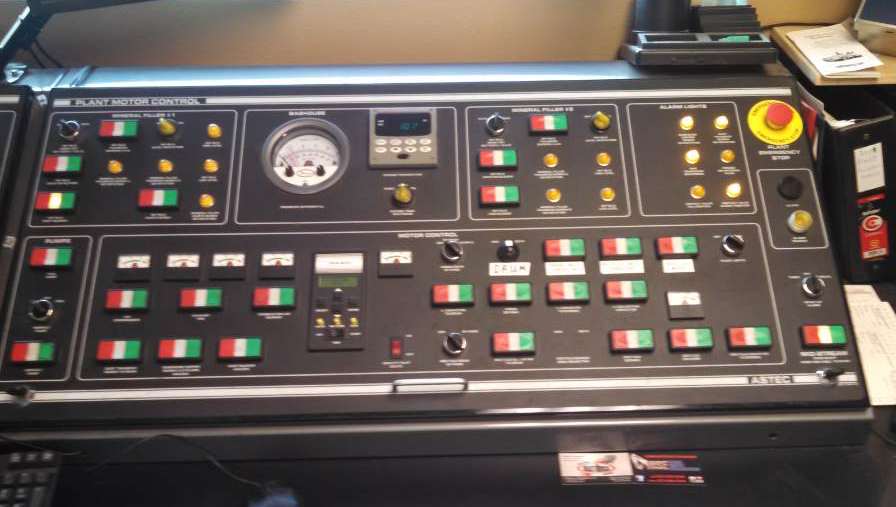
Coastal Bridge acquired the plant in Tampa only two years ago. It plans to significantly ramp up production at the plant and establish a fifth paving crew in Tampa.
“You didn’t see that volume increase with other foamers,” Langley remembered. “We found with the Accu-Shear, because of the volume expansion it can create in the liquid, we have more fines being coated than without foaming or with our other foaming devices.”
“Think about flour—we have dust in this hot mix that’s that fine or finer,” Langley said. “Trying to coat that in a mass of 350 tons an hour gets to be a problem, but with foaming and expanding that liquid and changing its viscosity, that material gets coated better and we see that coming out of our drum. They’re coated better, from big to little.”
Now, Coastal Bridge foams every mix it makes, unless the specs forbid the practice.
Benefits Well Beyond Warm Mix with Stansteel’s Accu-Shear Blending System
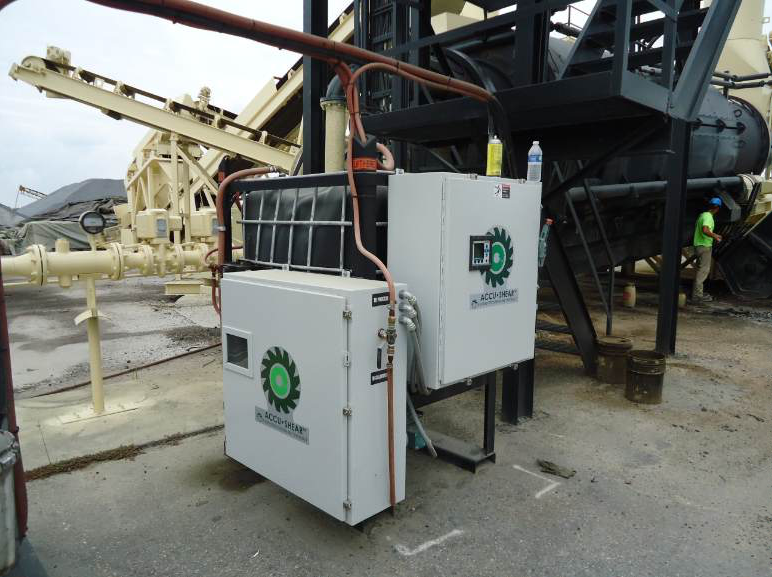
The Accu-Shear comes with a 275-gallon water tote with a fill valve with auto shutoff, mounted water and electrical enclosures, and lifting eyes and forklift pads.
Langley estimates that foaming has saved Coastal Bridge between 8 and 10 percent a year in fuel costs and has substantially reduced its carbon footprint.
By using the Accu-Shear, Coastal Bridge also saw the amperage draw on its slat conveyors decrease when running a dynamically foamed mix. Langley also discovered he could keep foamed mixes in the silo longer and that the material released and flowed better.
“It’s funny that you can run the same amount of material foamed and still see a 10 percent or so drop in amperage,” he said. “It just generally seems that the foamed mixture doesn’t stick as bad or doesn’t have as much resistance as it’s sliding up that steep plate.” Consequently, the machine’s motor doesn’t have to work as hard.
Although foamed mix can stay in the silo longer, Langley said it’s hard to expand your silo, even if you hit the right numbers. Langley said the contractor picks the time he or she wants to hold mix in the silo, where it’s tested at certain time intervals.
“It’s the long-term testing that makes it impractical because the contractor and technician must both be present to test the mix—and you can’t use that one silo for anything else during this time,” Langley said. “Therefore, it makes it hard to increase silo storage time.”
But, he adds, after foaming the mix, it does stay up a little longer and comes out of those silo doors easier.
Generally, Coastal Bridge limits the range it hauls mix to 80 to 100 miles away from the plant. But, with properly foamed mix allowed to be made at a lower temperature, Langley reports they can go up to 30 percent further without reductions in temperature.
“If you put two trucks on the same road,” he said, “one full of mix at 330 degrees and one at 290, they’ll probably be the same temperature by the time they arrive on the job.”
Another place the foamed mix makes a big difference is for Coastal Bridge’s four laydown crews. Langley reports seeing increased compaction on foamed mix, even when the crew uses the same roller, in the same manner, with the same number of passes.
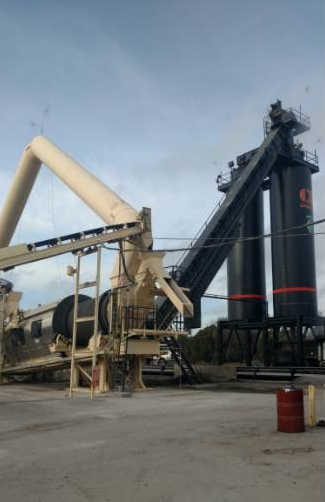
Coastal Bridge’s asphalt plant in Convent is equipped with an Accu-Shear Blending System from Stansteel.
That means the crew can reduce its compaction effort by up to three passes, in some cases.
“That saves them 15 minutes, which means they’re 15 minutes further down the road,” Langley said. That means the crew is moving faster with fewer passes, an increased paver speed, and is laying more in terms of total tons by the end of the day.
“We used to think with rolling it was the hotter the better, but that’s not always true,” Langley said. “Working with mix at a lower temp might actually put it in a better temperature zone for compaction. If it’s too hot, the mat won’t react right. It’ll want to move and you could choke or push it.”
Langley also said it’s easier for the crew to work with a 300-degree mix than one that’s 325 degrees or higher.
Coastal Bridge is one of only a few companies using liquids modified with ground tire rubber (GTR).
“What’s funny is if it drops to 300 degrees, it doesn’t get any stiffer,” Langley said. “It still works as good at 300 for handwork as it did at 325 or 340 because of foaming.”
Overall, Langley said, the crews like working with the foamed mix.
“When we first started experimenting with shingles, they complained,” he recalled. “But they’ve never complained about this.”
What Makes a Mix “Warm”
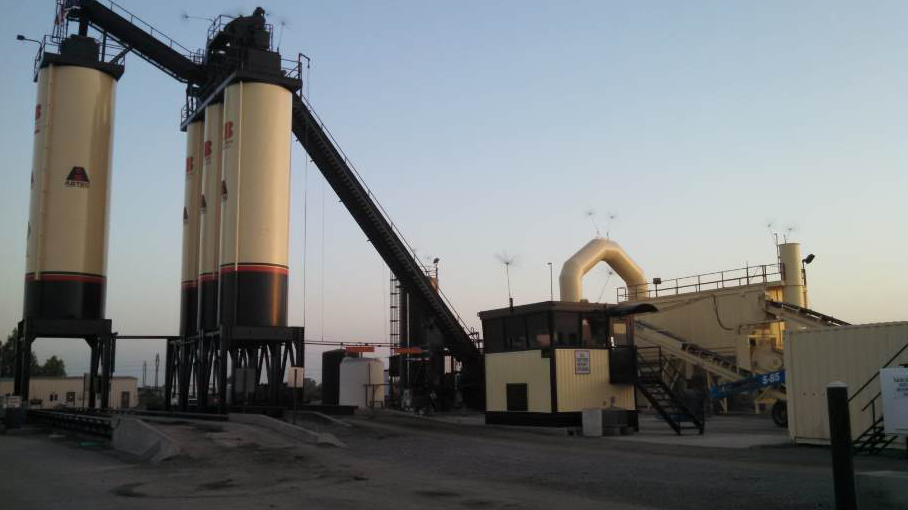
This Coastal Bridge plant is located in Port Allen, just west of Baton Rouge.
In Louisiana, Langley said, the state wants to see a reduction in temperature if a plant is foaming its mix. However, the lower limit is typically 275 degrees.
Coastal Bridge runs at 290 degrees, for a bit of added flexibility.
“If it gets lower than 275, the inspector has a reason to throw it away,” Langley said. “We wanted to make sure that doesn’t happen, so we bumped it up to between 290 and 300 degrees.”
That means if they hit a wet spot in the stockpile and the temperature drops 10 or 15 degrees, the load is still acceptable. That extra bit of heat also had a positive impact on the mix quality.
“When we first started foaming, we were looking at mix coming out at 275 and thought, ‘Okay, it looks pretty good—better than it did without foaming,’” Langley said. “Then we kicked it up 10 degrees and thought,
‘That looks pretty dang good.’ So we went up a bit more to 290, and saw that it was way better than the first and somewhat better than the second.”
Producers can go below 275 degrees if the producer can provide substantial proof that the liquid can achieve the same standards at lower temperatures. That requires suppliers to write a letter confirming their materials can achieve those standards, but Langley said suppliers are often hesitant to do so.
“If [the supplier] says I can do it, but I have to run it a lot hotter and spend more fuel to get it where it needs to be, they know they’re going to be locked into an arbitration matter because the chemical didn’t do what it said it would,” Langley said.
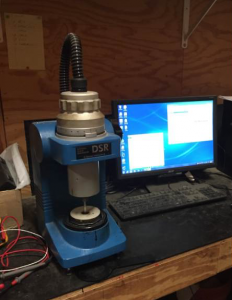
Coastal Bridge performas nearly every type of test for virtually any specification, Langley said. The only thing Coastal Bridge doesn’t test for itself is liquid AC, instead buying certified liquid from refineries in the area.
Instead, most of Coastal Bridge’s mixes are Superpave. Around 70 percent of Coastal Bridge’s paving jobs are state work and 30 percent, private sales.
“In Louisiana, state work is predominantly a form of Superpave consisting of two sections—a true Superpave mix and thin lifts, which covers OGFC and other mixes as thin as ¾ of an inch,” Langley said.
“We also do Marshall Method mixes for older regimes in cities and parishes.” Coastal Bridge also makes airport mixes.
It has labs in each of its plants, but its main lab is in the Baton Rouge plant.
“We can run all the tests we need for virtually any specification,” Langley said. The only thing Coastal Bridge doesn’t test for itself is liquid AC, instead buying certified liquid from refineries in the area.
“The only AC we test is DSR, dynamic shear rheometer, which the state requires we run daily. The fancier tests we ship out to private testing labs.”
Langley estimates that the percentage of RAP Coastal Bridge runs is anywhere from 15 to 30 percent, depending on the job specifications.
They’ve toyed with recycled asphalt shingles (RAS), he adds, but he says he’s still learning.
“Most mix we’ve run with RAS has been on a purely experimental basis,” he said. “The owner of Coastal Bridge develops subdivisions, so we’ll pave a street as we try to learn how to handle RAS, find the right rejuvenators and compile data in the hope that one day we can have the process right and get the state to do a study to allow RAS in specifications.”
Coastal Bridge Experiments with the Accu-Shear
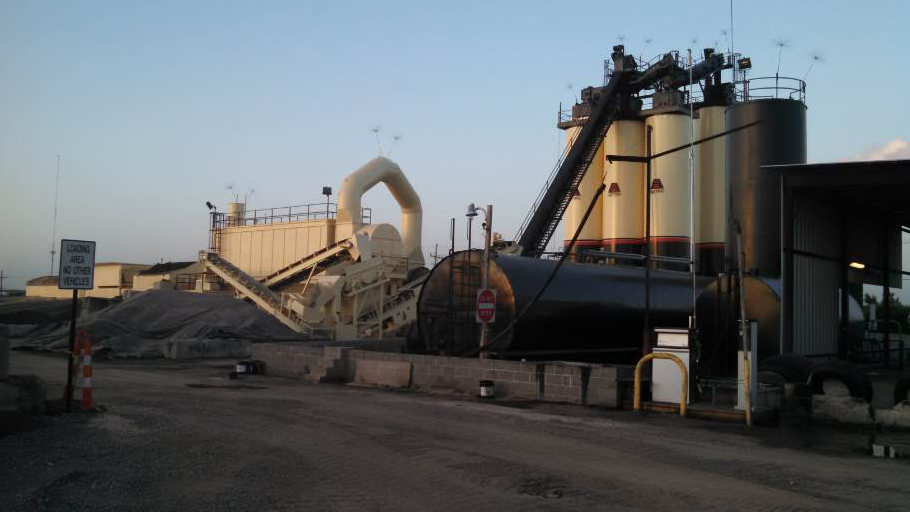
This Coastal Bridge plant is located in Port Allen, just west of Baton Rouge.
Coastal Bridge also uses its Accu-Shear to make its cold mix, produced at its Baton Rouge plant. “We run our cold mix liquids through the Accu-Shear to enhance our cold mix—one of them being latex to turn our cold mix into polymerized cold mix. It’s SBR, not SBS.”
That’s also the plant where Langley has done his experiments with RAS, as well as experiments with various chemicals for rejuvenation, and rejuvenating and foaming at the same time.
With the Accu-Shear, users can buy them with a handful of ports to inject several different liquids at the same time, or simply as a water foamer.
Langley is even thinking about getting a second Accu-Shear for the Baton Rouge plant, for a number of reasons. First, he wants to better integrate antistrip into his mix.
Louisiana requires plants to use a minimum of .5 percent antistrip of any brand the plant chooses. Langley said most plants use an amino-based antistrip. However, Coastal Bridge can’t use the Accu-Shear system for this particular mix design process because the specs require it to be injected after the sampling point when blending latex or some other type of product into the liquid.
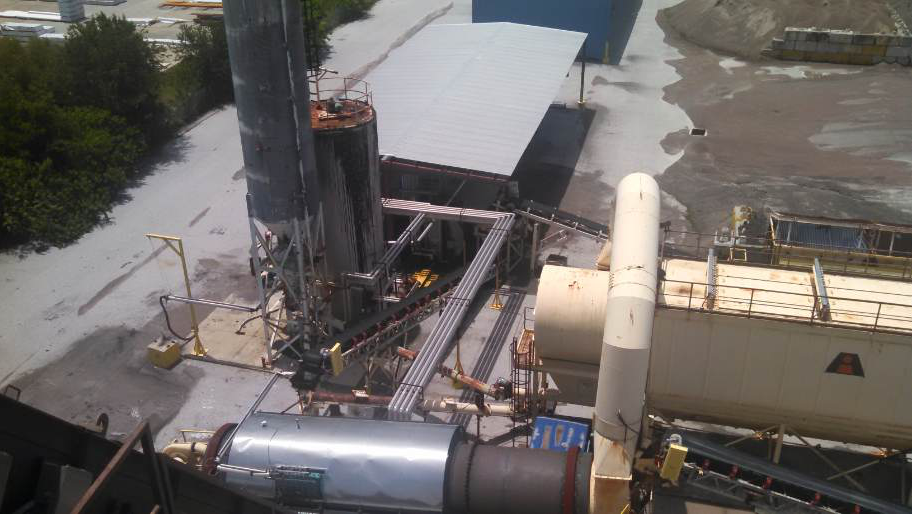
Coastal Bridge acquired the plant in Tampa only two years ago. It plans to significantly ramp up production at the plant and establish a fifth paving crew in Tampa.
“They want to test that the latex is doing what it’s supposed to be doing, and some antistrips when mixed with liquid can cause it not to meet the particular grade qualities,” Langley said.
Second, he wants to do some experiments with rejuvenators and expand the variety of products he may want to add, especially as he continues his RAS and RAP experiments.
“I feel we need to rejuvenate the liquid before we foam it, especially if I get big into the use of rejuvenators or other chemicals,” Langley said, which is a possibility if he continues his work with RAP and RAS. “If I’m running 50 percent RAP or 5 percent RAS, I may not want to do everything all in one Accu-Shear.”
Having two Accu-Shears at one plant also means that Langley can test the mix after adding a rejuvenator, but before its foamed, and then test a second time on the blended modified liquid. “I think foaming needs to be in the last section,” he said. “At the price of an Accu-Shear, I’d rather have two and be prepared for the future.”
“When we want to do something with our Accu-Shear,” Langley said, “Stansteel can normally come up with an answer for us. It’s been a great relationship for us, to be able to try out so many new things.”
